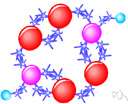adduct
Also found in: Thesaurus, Medical, Encyclopedia, Wikipedia.
ad·duct
(ə-dŭkt′, ă-dŭkt′)tr.v. ad·duct·ed, ad·duct·ing, ad·ducts Physiology
To draw inward toward the median axis of the body or toward an adjacent part or limb.
n. Chemistry
A chemical compound that forms from the addition of two or more substances.
[Back-formation from adductor.]
ad·duc′tion n.
ad·duc′tive adj.
American Heritage® Dictionary of the English Language, Fifth Edition. Copyright © 2016 by Houghton Mifflin Harcourt Publishing Company. Published by Houghton Mifflin Harcourt Publishing Company. All rights reserved.
adduct
(əˈdʌkt)vb (tr)
(Physiology) (of a muscle) to draw or pull (a leg, arm, etc) towards the median axis of the body. Compare abduct2
n
(Chemistry) chem a compound formed by direct combination of two or more different compounds or elements
[C19: from Latin addūcere; see adduce]
adˈduction n
Collins English Dictionary – Complete and Unabridged, 12th Edition 2014 © HarperCollins Publishers 1991, 1994, 1998, 2000, 2003, 2006, 2007, 2009, 2011, 2014
ad•duct
(v. əˈdʌkt; n. ˈæd ʌkt)v.t.
1. to move or draw toward the axis of the body or one of its parts (opposed to abduct).
n. 2. a combination of two or more stable chemical compounds by means of van der Waals' forces, coordinate bonds, or covalent bonds.
[1830–40; < Latin adductus, past participle of addūcere; see adduce]
ad•duc′tive, adj.
Random House Kernerman Webster's College Dictionary, © 2010 K Dictionaries Ltd. Copyright 2005, 1997, 1991 by Random House, Inc. All rights reserved.
adduct
Past participle: adducted
Gerund: adducting
| Imperative |
|---|
| adduct |
| adduct |
Collins English Verb Tables © HarperCollins Publishers 2011
ThesaurusAntonymsRelated WordsSynonymsLegend:
Switch to new thesaurus
| Noun | 1. |  adduct - a compound formed by an addition reaction adduct - a compound formed by an addition reactionchemical compound, compound - (chemistry) a substance formed by chemical union of two or more elements or ingredients in definite proportion by weight |
| Verb | 1. |  adduct - draw a limb towards the body; "adduct the thigh muscle" adduct - draw a limb towards the body; "adduct the thigh muscle"abduct - pull away from the body; "this muscle abducts" |
Based on WordNet 3.0, Farlex clipart collection. © 2003-2012 Princeton University, Farlex Inc.
Translations
adduit
ad·duct
vt. aducir, mover hacia la línea media.
English-Spanish Medical Dictionary © Farlex 2012